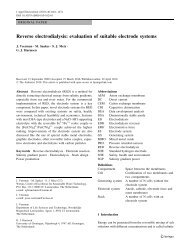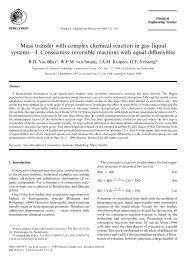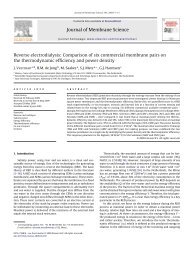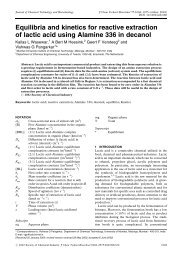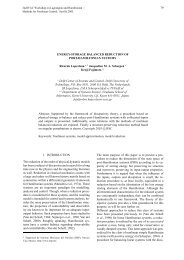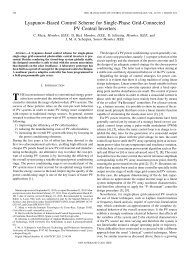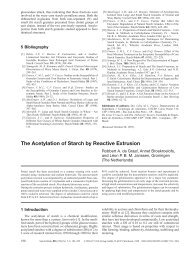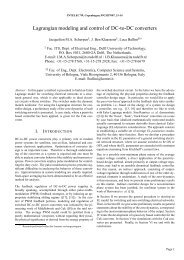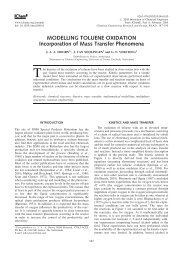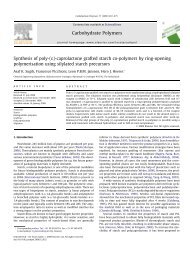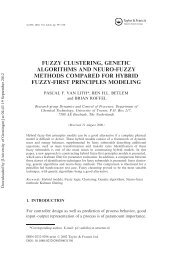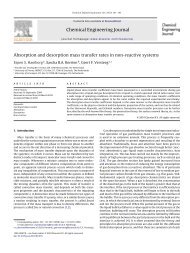1518 M. Seslija et al. / Journal of Geometry and Physics 62 (2012) 1509–1531The proposed definition of the dual boundary opera<strong>to</strong>r assures the validity of the summation by parts relation thatparallels the integration by parts formula for smooth differential forms.Proposition 3.1. Let K be an oriented well-centered simplicial complex. Given a primal (k − 1)-form α k−1 and a dual (n − k)-discrete form ˆβ n−k , then⟨dα k−1 ∧ ˆβ n−k , K⟩ + (−1) k−1 ⟨α k−1 ∧ d ˆβ n−k , K⟩ = ⟨α k−1 ∧ ˆβ n−k , ∂K⟩,where in the boundary pairing α k−1 is a primal (k − 1)-form on ∂K , while ˆβ n−k is a dual (n − k)-cochain taken on the boundarydual ⋆(∂K).Proof. We haveand⟨dα k−1 ∧ ˆβ n−k , K⟩ =σ k−1 ∈K= σ k−1 ∈K= σ k−1 ∈K⟨dα k−1 , σ k ⟩⟨ ˆβ n−k , ⋆ i σ n−k ⟩⟨α k−1 , ∂σ k ⟩⟨ ˆβ n−k , ⋆ i σ n−k ⟩σ k−1 ≺σ k ⟨α k−1 , σ k ⟩⟨ ˆβ n−k , ⋆ i σ n−k ⟩,⟨α k−1 ∧ d ˆβ n−k , K⟩ = σ k−1 ⟨α k−1 , σ k−1 ⟩⟨d ˆβ n−k , ⋆ i σ k−1 ⟩ = σ k−1 ⟨α k−1 , σ k−1 ⟩⟨ ˆβ n−k , ∂(⋆ i σ k−1 )⟩= σ k−1 ⟨α k−1 , σ k−1 ⟩ σ k−1 ≺σ k ⟨ ˆβ n−k , ⋆ i (s σ kσ k )⟩ + ⟨ ˆβ n−k , ⋆ b (s σ k−1σ k−1 )⟩Inducing the orientation of the dual such that s σ k = s σ k−1 = (−1) k completes the proof.ˆβRemark 3.3. Decomposing the dual form ˆβ n−k in<strong>to</strong> the internal and the boundary part as ˆβ n−k = i ∈ Ω n−k (⋆ d i K) on ⋆ i Kˆβ b ∈ Ω n−k (⋆ d b K) on ∂(⋆K) anddecomposing the dual <strong>exterior</strong> derivative in the same manner, the summation by parts formula can be written as⟨dα k−1 ∧ ˆβ i , K⟩ + (−1) k−1 ⟨α k−1 ∧ (d i ˆβ i + d b ˆβ b ), K⟩ = ⟨α k−1 ∧ ˆβ b , ∂K⟩. (3.1)□.In the standard literature of discrete <strong>exterior</strong> calculus, the codifferential opera<strong>to</strong>r is adjoint <strong>to</strong> the discrete <strong>exterior</strong>derivative, with respect <strong>to</strong> the inner products of discrete forms [7]. According <strong>to</strong> Proposition 3.1, this is not the case since onthe right a term corresponding <strong>to</strong> the primal–dual pairing on the boundary appears. As the subsequent section demonstrates,this term is precisely responsible for the inclusion of the boundary variables in the discretized S<strong>to</strong>kes–Dirac <strong>structure</strong>.4. Dirac <strong>structure</strong>s on a simplicial complexThe S<strong>to</strong>kes–Dirac <strong>structure</strong>, which captures a differential symmetry of the Hamil<strong>to</strong>nian field equations, as presentedin [1], is metric-independent. The essence of its construction lies in the antisymmetry of the wedge product and the S<strong>to</strong>kestheorem. In a discrete framework, the primal–primal wedge product [7] inherits a number of important properties of thecup product [25], such as bilinearity, anti-commutativity and naturality under pullback; however, it is degenerate and thusunsuitable for defining a Dirac <strong>structure</strong>. This motivates a formulation of a Dirac <strong>structure</strong> on a simplicial complex and itsdual. We introduce Dirac <strong>structure</strong>s with respect <strong>to</strong> the bilinear pairing between primal and duals forms on the underlyingdiscrete manifold. We call these Dirac <strong>structure</strong>s simplicial Dirac <strong>structure</strong>s.In the discrete setting, the smooth manifold M is replaced by an n-dimensional well-centered oriented manifold-likesimplicial complex K . The flow and the effort spaces will be the spaces of complementary primal and dual forms. Theelements of these two spaces are paired via the discrete primal–dual wedge product. Since the S<strong>to</strong>kes–Dirac <strong>structure</strong> Dexpresses the coupling between f p and e q , also f q and e p , via the <strong>exterior</strong> derivative, whose discrete analogue maps primalin<strong>to</strong> primal and dual in<strong>to</strong> dual cochains, the flow space cannot be entirely built on a primal simplicial complex and the effortspace on a dual cell complex, or vice versa. Instead, the flow and the effort spaces will be mixed spaces of the primal anddual cochains. One of the two possible choices isandF d = Ω p (⋆ p,q d i K) × Ω q n−pd(K) × Ωd(∂(K))E d p,q = Ω n−pd(K) × Ω n−q(⋆ i K) × Ω n−q(∂(⋆K)).dd
M. Seslija et al. / Journal of Geometry and Physics 62 (2012) 1509–1531 1519The primal–dual wedge product ensures a bijective relation between the primal and dual forms, between the flows andefforts. A natural discrete mirror of the bilinear form (2.1) is a symmetric pairing on the product space F d × p,q E d p,q definedby1⟨⟨(ˆf , p f 1 , q f 1b, e 1 p , ê1, q ê1 2b), (ˆfp , f 2 , q f 2 , b e2, p ê2, q ê2)⟩⟩ b d∈F dp,q∈E d p,q= ⟨e 1 ∧ 2pˆf + p ê1 ∧ q f 2 + q e2 ∧ 1pˆf + p ê2 ∧ q f 1 , K⟩ + q ⟨ê1 ∧ b f 2 + b ê2 ∧ b f 1b, ∂K⟩. (4.1)A discrete analogue of the S<strong>to</strong>kes–Dirac <strong>structure</strong> is the finite-dimensional Dirac <strong>structure</strong> constructed in the followingtheorem.Theorem 4.1. Given linear spaces F dp,q and E d p,q , and the bilinear form ⟨⟨, ⟩⟩ d . The linear subspace D d ⊂ F d × p,q E d p,q ˆfpepD d =(ˆfp , f q , f b , e p , ê q , ê b ) ∈ F d × p,q E d p,q f b = (−1) p e p | ∂Kis a Dirac <strong>structure</strong> with respect <strong>to</strong> the pairing ⟨⟨, ⟩⟩ d .=f q0 (−1) pq+1 d id 0+ (−1) pq+1 dbê q 0ê b ,defined byProof. In order <strong>to</strong> show that D d ⊂ D ⊥ d , let (ˆf 1, p f 1,q f 1,b e1, p ê1, q ê1) ∈ D 2b d, and consider any (ˆf , p f 2,q f 2,b e2, p ê2, q ê2) ∈ D b d.Substituting (4.2) in<strong>to</strong> (4.1) yields⟨(−1) pq+1 e 1 p ∧ d i ê 2 q + d bê 2 b+ ê1q ∧ de2 p + (−1)pq+1 e 2 p ∧ d i ê 1 q + d bê 1 b+ ê2q ∧ de1 p , K⟩+ (−1) p ⟨ê 1 ∧ b e2 + p ê2 ∧ b e1 p, ∂K⟩. (4.3)By the anticommutativity of the primal–dual wedge product on K⟨ê 1 q ∧ de2 p , K⟩ = (−1)q(p−1) ⟨de 2 p ∧ ê1 q , K⟩⟨ê 2 q ∧ de1 p , K⟩ = (−1)q(p−1) ⟨de 1 p ∧ ê2 q , K⟩,and on the boundary ∂K⟨ê 1 b ∧ e2 p , ∂K⟩ = (−1)(p−1)(q−1) ⟨e 2 p ∧ ê1 b , ∂K⟩⟨ê 2 b ∧ e1 p , ∂K⟩ = (−1)(p−1)(q−1) ⟨e 1 p ∧ ê2 b , ∂K⟩,the expression (4.3) can be rewritten as(−1) q(p−1) ⟨de 2 p ∧ ê1 q + (−1)n−p e 2 p ∧ d i ê 1 q + d bê 1 b, K⟩ + (−1) q(p−1) ⟨de 1 p ∧ ê2 q + (−1)n−p e 1 p ∧ d i ê 2 q + d bê 2 b, K⟩+ (−1) p+(p−1)(q−1) ⟨ê 1 b ∧ e2 p + ê2 b ∧ e1 p , ∂K⟩.According <strong>to</strong> the discrete summation by parts formula (3.1), the following holds⟨de 2 ∧ p ê1 + q (−1)n−p e 2 ∧ pd i ê 1 + q d bê 1 b , K⟩ = ⟨e2∧ p ê1, ∂K⟩ b⟨de 1 ∧ p ê2 + q (−1)n−p e 1 ∧ pd i ê 2 + q d bê 2 b , K⟩ = ⟨e1∧ p ê2, ∂K⟩. bHence, (4.3) is equal <strong>to</strong> 0, and thus D d ⊂ D ⊥ d .Since dim F dp,q = dim E d p,q = dim D d, and ⟨⟨, ⟩⟩ d is a non-degenerate form, D d = D ⊥ d .Remark 4.1. As with the continuous setting, the simplicial Dirac <strong>structure</strong> is algebraically compositional. Since the simplicialDirac <strong>structure</strong> D d is a finite-dimensional constant Dirac <strong>structure</strong>, it is integrable.The other possible discrete analogue of the S<strong>to</strong>kes–Dirac <strong>structure</strong> is defined on the spacesF˜d = Ω p (K) × Ω q (⋆ p,q d d i K) × Ω n−p(∂(⋆K))Ẽ d p,q = Ω n−pd(⋆ i K) × Ω n−q(K) × Ω n−q(∂K).dddA natural discrete mirror of the bilinear form (2.1) in this case is a symmetric pairing on the product space ˜by⟨⟨(f 1 , 1pˆf , 1qˆfb, ê 1 p , e1, q e1 b), (f 2p , 2 ˆf , 2qˆf , b ê2, p e2, q e2 b )⟩⟩˜d∈F˜p,qd∈Ẽ d p,q= ⟨ê 1 p ∧ f 2p + e1 q ∧ ˆf2q + ê2 p ∧ f 1p + e2 q ∧ ˆf1q , K⟩ + ⟨e1 b ∧ ˆf2b + e2 b ∧ ˆf1b , ∂K⟩.□(4.2)F dp,q ×Ẽd p,q defined



